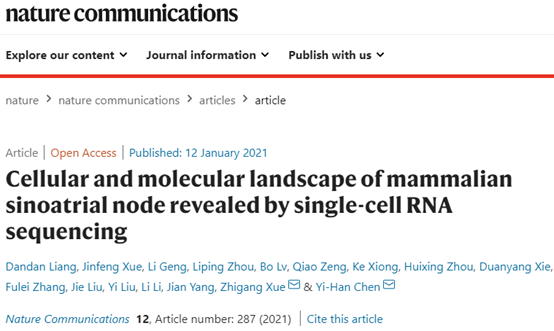The human heart beats at a rate of 60-100 times per minute to pump blood to the organs of the body and maintain the normal function of life. The control "centre" or the Supreme Command of the heartbeat is the sinoatrial node, which was discovered more than a century ago but is still poorly understood in academic circles. The sinoatrial node is located in the atrium. It is a small tissue with little interstitial cells which are difficult to separate or analyze, thus hindering progress in effective research around the world.
Recently, with the help of pacemaker cell separation technology, single-cell transcriptome sequencing and analysis technology, cell imaging technology, gene modification technology and cell differentiation induction, as well as a series of electrophysiological techniques, the researchers of Tongji University have analyzed the core gene regulatory network of sinoatrial node pacemaker cells from the single-cell resolution level and found important biomarkers that impact sinoatrial node pacemaker cells.

Many questions have been left unanswered in the field of sinoatrial node biology and medical research. These include for example: what is the molecular cell system of sinoatrial node pacemaker cells? Is there a dominant cluster of pacemaker cells in the sinoatrial node? What is the core gene regulatory network that controls the function of sinoatrial node pacemaker cells? What are the specific biomarkers for sinoatrial node pacemaker cells?
Researchers from Tongji University have revealed the cluster types and molecular systems of sinoatrial node pacemaker cells in three species, namely mice, to rabbits and monkeys. They have preliminarily findings, through informatics technology and functional verification, that sinoatrial node pacemaker cells of different species all contain a dominant cluster that controls the beating of the heart. Researchers also found that these clusters of cells were dispersed in different regions of the sinoatrial node, a distribution that may facilitate the maintenance of heart rate homeostasis. They identified the core gene regulatory network that controls the heart beating, where individual molecules have been proved, through their experiments, to significantly regulate the frequency of the heartbeat. Some transcription factors are also in the network, as the results shown. Moreover, they found the biomarkers of sinoatrial node pacemaker cells, suggesting that Vsnl1 may be a biomarker to identify pacemaker cells and research arrhythmia. The above findings have provided basic data for the study of the sinoatrial node, paving the way for further research on sinoatrial node biology, pathology and therapeutics.
The study was recently published online in the journal Nature Communications. The authors are academicians CHEN Yihan of Tongji University School of Medicine and Shanghai East Hospital, Tongji University, and XUE Zhigang of Tongji University School of Medicine, and the first author is LIANG Dandan, researcher of Shanghai East Hospital, Tongji University.
Original link: https://www.nature.com/articles/s41467-020-20448-x
Source: https://news.tongji.edu.cn/info/1002/76387.htm
